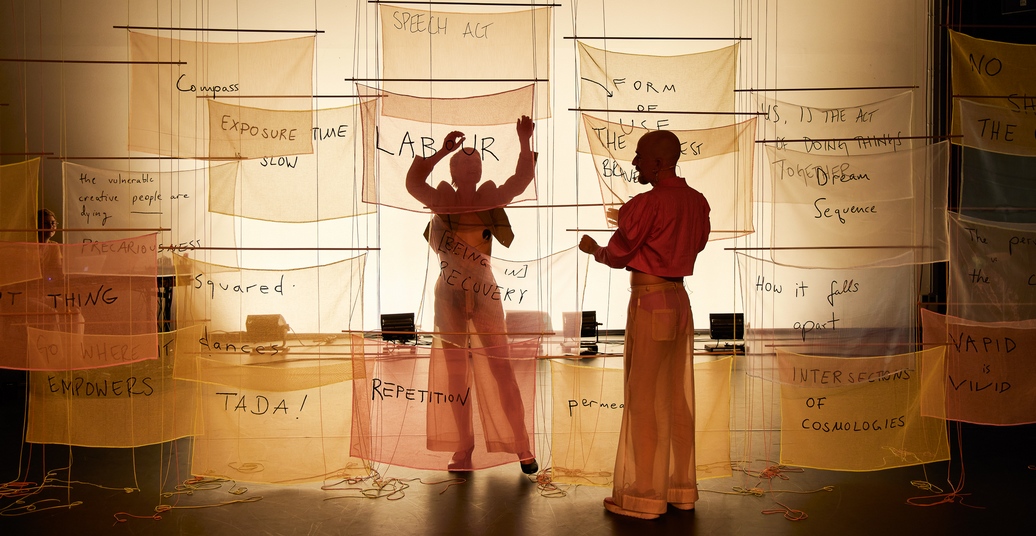How can an archive be performed? How can a research process be shown on stage without the result being dull and didactic? How can a dance be devised about a show that premiered more than 40 years ago? In “Try Leather”, Britta Wirthmüller, William Locke Wheeler, and Justine A. Chambers explore the political and performative aspects of an eponymous 1975 solo by Canadian artist and activist Margaret Dragu. Choosing a dozen different archive records and key words each night, Wirthmüller and Wheeler offer their personal take on Dragu’s work and life in a show that combines dance, spoken word, and audio fragments.
“Try Leather” premiered online 22 June 2021 during Open Spaces – Making It Happen #2 festival. Its delicate yet candid approach to memory and archiving inspired me to share my own ‘archive records’ of the sultry evening when I saw the pre-premiere of “Try Leather”.
Margaret Dragu
Before the show starts, I quickly check the programme to learn a bit more about Margaret Dragu. She is a Vancouver-based performance artist, stripper, and political activist. Her original solo “Try Leather” premiered in 1975 and was a fine mix of stripping, modern dance, and political activism. After years of legal battles, Dragu created the first strippers’ labour union, The Canadian Association for Burlesque Entertainers. Dragu could not travel to Berlin to take part in this new performance based on her work due to health issues, so only her voice appears during short audio interludes. The rest of the story is told — but also danced — by Wirthmüller and Wheeler.
Banners and Voices
The rules of the game are disclosed at the outset: the stage design consists of a large wall of half-transparent banners featuring key words from an archive that Wirthmüller and Dragu had prepared during their research period. Led by Kasia Wolińska from behind the banners, together the company select a dozen banners seemingly at random (this time they decided to choose ‘their favourites’) in order to perform these archive records. Each night they show a different piece, and the dramaturgy is always decided on the spot. The performers discuss it extensively onstage, exchange jokes, and ask Wolińska to dim the lights toward the end of show, to which she replies that they have only eight minutes left to perform because the audience “is lacking oxygen.” I have rarely seen a dance show that is so candid about its inner structure and research process. Wirthmüller tells the story of meeting Margaret Dragu, biking to her place and drinking tea together. Dragu’s voice even interrupts the show to explain the context of “Try Leather” and to share her views on performance politics and stripping.
Chair Dance and Balloon Dance
The work is not only based on text material, however. Both dancers perform short variations and fragments from Dragu’s solo. Wirthmüller shows a ‘chair dance’ that is clearly reminiscent of strip dance vocabulary with its suggestive knee movements, quick turns to the side, and brief arm extensions. Together with Wheeler, they also reinvent the marching sequence and the ‘balloon dance’ from Dragu’s original work, in which they wear balloons attached to their waists and mouths. If these short dance interludes are perhaps slightly over-methodical in feel, the work reaches its emotional heights during the ‘dream sequence’ in which Dragu, interpreted by Wheeler, spins around while crying out the names of loved ones she has lost — ex-lovers, friends, and family members. But even here in the midst of high emotion, the piece does not lose sight of its aim to showcase Dragu’s work, and all the dance sequences are introduced or commented on by the performers or Dragu herself.
Down Memory Lane
All the elements of “Try Leather” are deftly sewn together by a series of references and seamless transitions. Wirthmüller wears nipple pasties and a transparent skirt as reminders of Dragu’s past as a stripper, and the music choice includes Elvis Presley’s “Are You Lonesome Tonight?” which is mentioned in one of Dragu’s audio recordings. Even an old TV-screen, the sound of a typewriter, and the pastel-beige light design work towards a general feel of nostalgia. When the lights go down, the audience finally sees fluorescent threads connecting the banners to one another, and I cannot help but think about all those stories left untold that were probably told during other performances of ‘Try Leather’. Even though one may have thought, perhaps, that such a deep and detailed insight into Margaret Dragu’s life and career may appear of limited interest to a non-specialist audience, this smart and nostalgic show proves that performing an archive on a theatre stage can be an exciting adventure. Wirthmüller and Wheeler deploy a full range of tactics to shed light on the hard work behind the show’s conception, and the result is a rare pleasure to watch.
The video of “Try Leather“ by Justine A. Chambers, Margaret Dragu, William Locke Wheeler, Britta Wirthmüller is still available until tonight, 27 June 2021 / 23:00 free of charge on the website of Tanzfabrik Berlin.
Credits:
Concept, choreography: Justine A. Chambers, Margaret Dragu, William Locke Wheeler, Britta Wirthmüller | Dance: Justine A. Chambers, Margaret Dragu, William Locke Wheeler, Britta Wirthmüller, Kasia Wolińska | Set design: William Locke Wheeler | Outside Eye: Kasia Wolińska | Sound design, technical direction: Nikola Pieper | Video: Walter Bickmann/Tanzforum Berlin | Production management: Dino Spiri | PR: Denhart van Harling | Graphic design: Carsten Stabenow, Milchhof Atelier | Photos: Anja Weber.




